Can You Eat Squash Leaves?
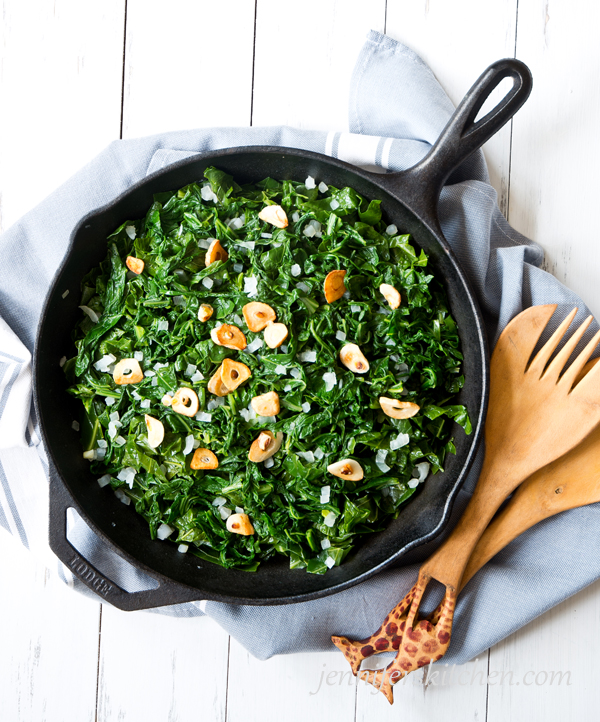
This website is brought to you without annoying ads because we can live healthier lives without the influence of marketing. But running a high-traffic site is expensive. How can you help? If you purchase anything through the affiliate links on my site, your cost is the same, but I receive a small commission. Thank you!
While living on a different continent for a few months this year, I had the privilege of eating a variety of foods that I’ve never tried before, like njugu beans, uji, pumpkin leaves, and African millet (which is nothing, nothing, nothing even close to our millet).
I also got to re-try a few that I hadn’t had in a long time, like tamarillos, plantains, and sorghum (which we will be eating more of it at home now that I see how yummy it can be).
Thankfully, I avoided the dried, baby fish.
Secret Sauce
With the exception of the African millet, all of the new foods were quite good – some because of the sauce that was served with every one of them (You’ve heard that hunger and gratitude make the best sauce, right?) and some because they were just really, really good!
But, hands down, my favorite of all were the squash leaves.
(All of the natives called them pumpkin greens, but in America we would call them squash greens because they grew on plants that produced what we call squash – like butternut squash and acorn squash.)
And to think I’ve been growing squash in my garden for years, and I had no idea you could eat the leaves of the squash plant – or that they were so scrumptious!
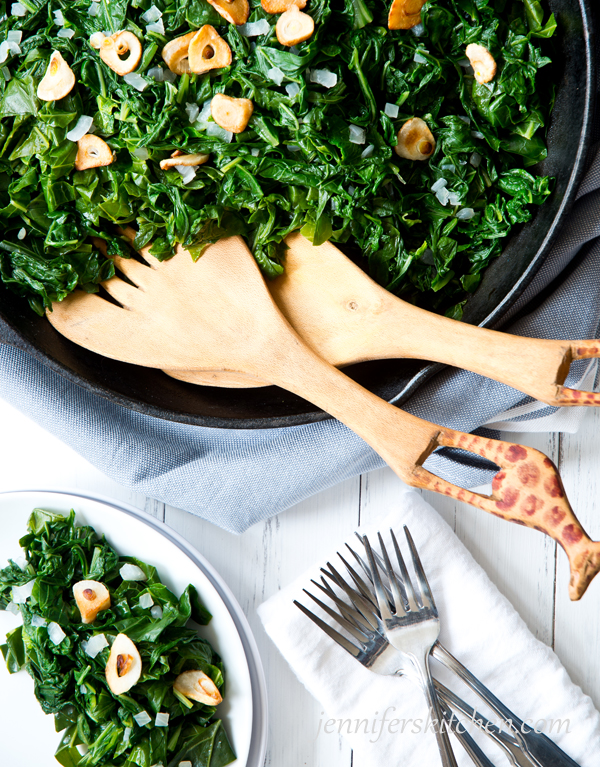
Where I was in Africa, almost everyone had a garden, and almost everyone had squash (pumpkin) greens growing in their garden; and they grew like crazy, so there were always plenty of greens to pick and enjoy. I will definitely plant squash this year in my garden – not just for the squash, but also for the greens.
Can you eat summer squash and zucchini leaves too?
I haven’t tried them (yet), but I’ve heard that zucchini and summer squash (courgette) leaves can be eaten as well. (Edit: Tried them this year. The young leaves are delicious.) Prepare them the same way you would prepare winter squash leaves.
(You can also eat the blossoms – but that is for another post.)
How to Prepare and Cook Squash or Pumpkin Greens
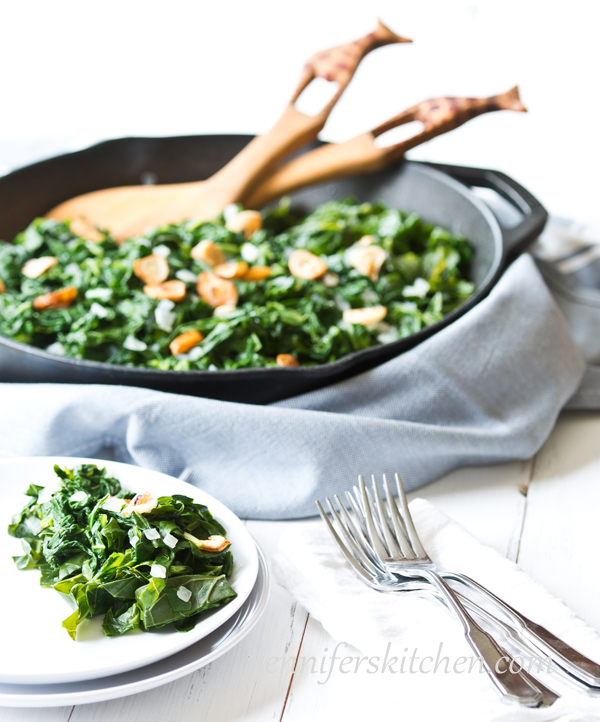
So, here’s how to cook squash greens and make them taste fabulous. (Get the exact recipe below.)
1. Pick the leaves. The young leaves are the best because they are tender. You can include some of the stem if you’d like; they are delicious too.
Squash greens are best used fresh. They wilt very easily, even when stored sprinkled with water, in a plastic bag, in the frig.
2. Wash well. If you have a sandy garden, you may want to immerse the greens in a sink full of water. The sand will sink to the bottom.
The African natives (at least the ones I talked to) peeled the tiny spines off the stems. We did this once, and then decided it wasn’t worth the time. Cooking breaks down the spines and you don’t notice them at all when eating the greens.
3. Dice an onion and sauté it. Add a clove or two of garlic and chopped greens and saute for a few minutes.
4. Add a little water or vegetable broth, a few diced tomatoes if you want to cook ’em like an African (just a very small amount, like 1/4 to 1/2 cup for a large pan of greens), cover, and cook until greens are tender.
What if I want to try squash greens, but I don’t have a garden?
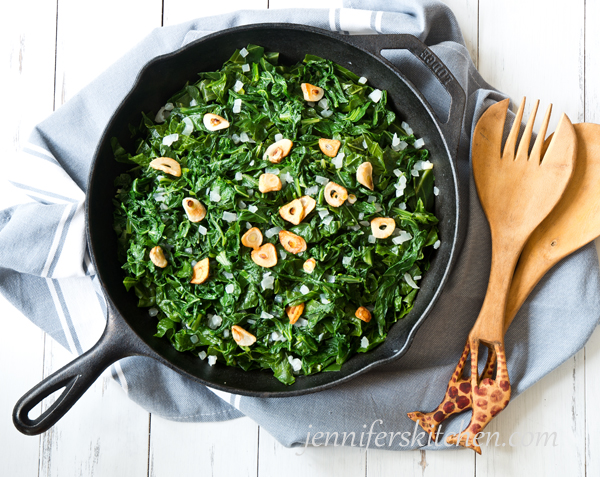
Squash greens are so good, it’s a pity to be limited to kale and collards; unfortunately, I’ve never seen squash leaves in the grocery store. The best solution is to grow your own in your garden, but what do you do if you don’t have a garden?
You can grow squash greens in a container. Even a small container will produce enough greens for a several meals (although it may not be able to support an actual squash).
Also, some farmer’s markets sell squash greens. If yours doesn’t, you could ask and I’m sure a grower would be happy to supply them to you.

Nutrition in Squash Greens
Squash greens are one of the most nutritious foods you can eat! They are loaded with calcium and iron, vitamins A, B, C, and K, magnesium, phosphorus, and copper. Together, these nutrients boost your immune system, help build strong bones, prevent anemia, and just plain help keep you healthy!
Squash Recipes
Once you’ve eaten all the leaves off your squash plants, you might want to make some yummy squash! Here are some great recipes for that!
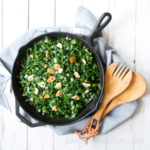
Squash Greens
Ingredients
- 1 large yellow or sweet onion, diced small
- 1 tablespoon olive oil
- 5 cloves garlic, minced
- 12 cups (packed) chopped squash leaves - (They cook down a lot!)
- 1/4 cup water - or vegetable broth
- 2 Roma tomatoes, diced small - optional
- 1 teaspoon granulated onion - optional
- salt - or to taste
Instructions
- Wash leaves well.
- In a large soup pot, sauté onion in oil over medium heat until onion begins to turn translucent – about 8 minutes.
- Meanwhile, cut the greens into 1 to 1 ½-inch pieces or strips.
- Turn heat to medium-high. Add garlic and greens to pot and sauté for about 3 minutes.
- Add water or broth and diced tomatoes (if desired). Cover, and cook for about 10 minutes or until greens are tender. Cooking time will vary depending on how young and tender your leaves are. Watch closely; if water boils away, add a little more, but don’t add too much or greens will lose flavor.
Notes
>> One quick request: if you like this recipe, please leave a rating and a comment. Ratings help more people find these healthy recipes!
Want More?
For more healthy and delicious recipes like this one that will simplify your journey to a healthier and thinner you, check out my
Leave a comment
Your comments make my day! 🙂
You my also like:
Before you go . . .
Did you know that you can eat all this delicious food AND lose weight? You can!
No calorie counting. No portion sizes.
Join my online weight loss program today!

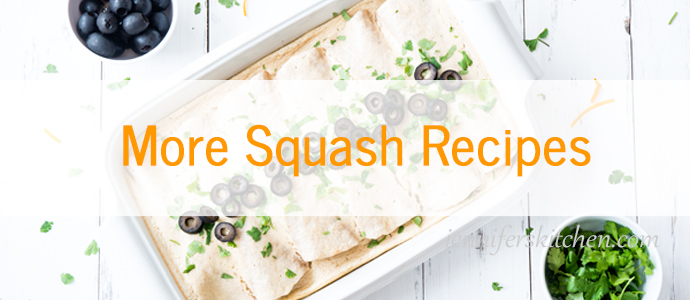
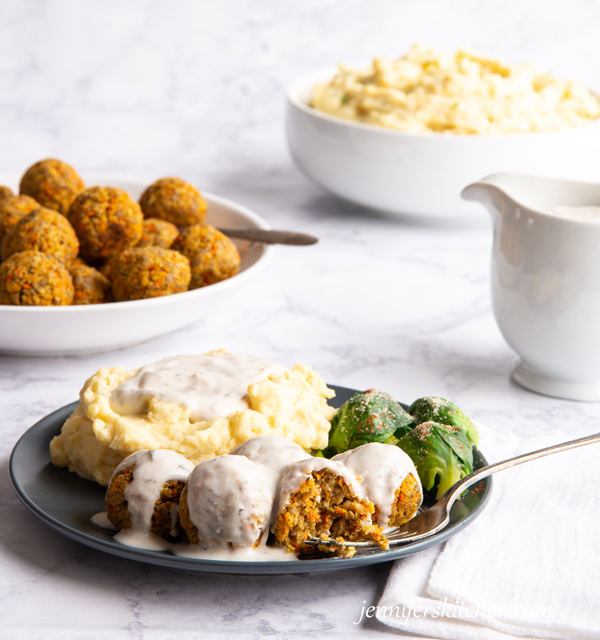
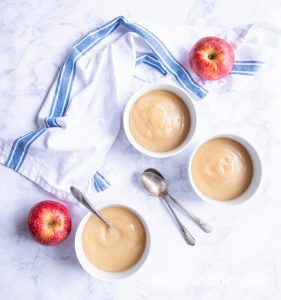
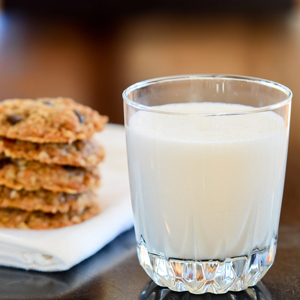

This new recipe sounds good. I will give it a try as soon as my squash plants are big enough to harvest some leaves.
Oh, and I LOVE the giraffe serving utensils. So cute!
I bought the giraffe utensils at a little Maasai market in Tanzania. I thought they were cute too! 🙂
I just googled can you at squash leaves and found your site. I have pumpkin plants growing on the incline of my backyard. I didn’t plant them but last fall I chopped up some free pumpkins for the squirrels and any and all nocturnal animals that go through the backyard. Lo and behold this spring I have pumpkins growing. Thank you mother nature. By the way try baking your potato skins that most people throw away after they peel them to make mashed potatoes. Wash them and toss them or spray them with olive or avocado oil and seasonings. Bake like kale chips. Waste not want not. I might try this recipe with the pumpkin leaves after I cut them smaller.
I cooked exactly as described above plus some spices green chilli etc it was indeed a delicious dish I ate with rice and bread.
Thank you for paying it forward with your beautiful website/recipes. I noticed many are vegan and easily adapted to a Vegan No Oil Lifestyle of which many people who have heart disease are under. As a nutritional consultant, I am curious to your thoughts about a vegan no oil diet and/or if you are familiar with Dr. Esselystn’s diet.
Hi Bejaka,
I truly appreciate the work of Dr. Esselstyn. A healthy, plant-based diet is certainly the key to avoiding – and even curing – many of the diseases we see in our society today. We not only see benefits for physical health, but for mental health as well, on a healthy, plant-based diet.
In addition to prescribing a plant-based diet, Dr. Esselsytn also recommends omitting oils from the diet – an approach I completely agree with. Oils are a highly refined food (not a whole food) and can contribute to disease. That said, I do include oil in my recipes because many of my clients are coming from a diet of pizza, fries, cheese, and other foods that contribute to weight gain, and a little oil seems to help with the transition to a healthier diet. I try to encourage my clients to continue to make adjustments and improvements in their diet and to gradually move toward a diet that is free of refined foods (like sugar and oil). And when I have a client who is dealing with high cholesterol or other risks of heart disease, I urge this even more.
Thanks for your comment. Hope you have a good day! 🙂
Jennifer
Forks over knives! Yes. I will try squash leaves but carefully. Although very rare, squash, egg plant and melons, cucumber especially wild or crossbred wild with domestic, stressed out, under watered, lacking fertilizer under insect attack can be extremely bitter, spit it out immediately and do not eat. The plants naturally produce cucirbitian which is toxic. Can make you very sick or fatally so. Wild cucumber is very bitter and the article warns of volunteer crops or ornamental gourds grown near eadible so be careful. It should not taste exceedingly bitter. I have heard you can eat squash flowers but I don’t know male from female. Female makes the squash company eat male only.
You can tell the male flowers from the female bones based on the shape of the base. Male flowers have just a long thin stem beneath the flower. Female flowers have a bulge or bump just below the flower and tend to have a very short stem. Hope that helps!
Greatmorning! 😊
I’m so amazed! Thanks I saw this site of you. Exactly what I was looking for. I’m not sure if I can cook the old leaves but nice to. So.. I researched. 😊 Boom!
I’m goin to cook this for our lunch. I have squash in my. Garden 😊Thank you. Have a good day. And godbless
Thank you. I eat many leafy plants but never thought of squash. or pumpkin leaves which I shall surely try.
Hi Joe. I hope you enjoy!
Hi Jennifer. This is my first time visiting your site. I live above 8,000 feet in the lower rockies of southeastern Colorado. I am growing cauliflower, broccoli, squash, melons and beets and was wondering if the greens were edible. I also grow carrots, spinach, kale, lettuce, cabbage, tomatoes string beans and apples. It’s very helpful to know what greens are good to eat and I thank you for sharing your knowledge. I moved out here from California’s central valley 6 years ago and every year has been part of an ongoing gardening learning experience. This winter and early spring I spent several hundred dollars and a lot of time building a bear, deer, elk, rabbit, squirrel and other varmint proof garden fence after a bear killed one of my apple trees last spring. Live and learn. Keep on gardening for life. Thanks again for taking the effort to help.
Welcome Michael.
So sorry to hear about your apple tree. It can sure be a challenge to keep the critters out. Our fence had a break in it this year (unbeknownst to us) and the deer had a midnight feast in our garden. 🙁 The challenges and rewards of gardening are never-ending. 🙂
I do know that cauliflower leaves, broccoli leaves, carrot leaves, and beet leaves are edible, and all except carrot leaves taste quite good in my opinion.
Thanks for your comment.
Happy gardening!
Jennifer
Include kohlrabi, turnip, hollyhock and dandelion. My husband said what are you doing with that bowl?! Picking dandelions for my salad. Noooo you might pick a look alike and poison yourself. Still makes me laugh. But yes there is a look alike-cat’s ears but we can east them just not your dogs. My parents grew kohlrabi. Never knew the greens are edible.
Your info is appreciated! Only last year did I discover that the leaves from bean plants were edible.
I am on a quest to eat healthy. I went from taking 6 shots of insulin last year to only one. Now I am working on getting rid if the last one.
Eating with mindful purpose is sooo important. I live in Portland, Oregon.
We have all sorts of wild edible greens. We also have a walnut tree (leaves are great in tea), a lot of blackberries, 3 Italian plum trees and much more. It’s great to be able to just go outside and pick from all that’s available on a daily basis. Sure saves on money.
Thanks again,
Cali
Hi Cali,
Congratulations on your improvements in your health. A plant-based diet sure is a great benefit to those with diabetes.
I’ve never tried bean leaves before; I’ll have to give them a go. How nice to have all those yummy edibles in your yard. We picked cherries a few days ago and are enjoying every one of them. 🙂
Thanks for your comment.
Jennifer
I have a very old bad of black eyed peas which I love, but the package warns pods not edible 🙁
We lived in Fiji for 7 months. We ate a lot of “pumpkin” greens… though I never saw a pumpkin over there come to think of it. I never thought to make them here in the states, but I will next summer!
Thanks
Carol
Pretty info on squash. I love your wooden spoon 👍
merrymj
I’ve got lots of squash sprouting in my lazy compost pile and had been turning them back into the pile until I started wondering why I couldn’t cook them or wash them off and put in my smoothies…anyone tried that?
Be very careful about volunteer crops. Can be great but Google toxic shock squash cucribtian.
Great read. What part of Africa where you in since it’s a large continent with different countries and so many different cultures?
Hi Ogom,
I was in Tanzania, Africa – south of Iringa. Certainly a beautiful country.
I live in Southern Africa and I haven’t tried squash leaves yet, will try the ones that sprouted on my compost by accident when they grow big enough…
Hi Sato! Thanks for your comment. I hope you get to try some squash leaves this year. They are delicious!
Jennifer
Please refer to the country you were in since Africa is a big continent with diverse cultures. It’s like saying i eat this vegetables the way asians would it…while they are so many countries and cultures.
I was in Tanzania
My front yard is covered with butternut squash vines, so I tried this (simple enough for even me!) recipe. The result is just about what I expected, filling and no doubt nourishing, but lacking in any particular flavor beyond the lingering aroma peculiar to squash. With salt, pepper, and a pat of butter, it makes a perfectly ordinary plate of greens. If food was scarce, something like this could be a life saver.
Sorry it wasn’t amazing for you Karl. When I started to eat healthier, I eventually grew to love greens – kale, collards, etc. – so maybe that’s why these taste delicious to me. The onion, garlic, and tomatoes add nice flavor in my opinion. Sorry it wasn’t the same for you. But at least you know what to eat during a famine 😉
I decided to try this recipe this evening since we are getting a killing frost tonight -nothing to lose I figured. Well, HELLO!!!! I’m SO SAD that the pumpkin/squash leaves are going to be gone, because this recipe is FANTASTIC!!!! I threw in one of my last tomatoes as well……I can’t WAIT til next summer!!!
Wonderful! SO happy you enjoyed them, April. 🙂
Thank you for all that information; I’m going to harvest some leaves right now and try your recipe. Here’s a tip for you: a good way to get sand or dirt from your greens is to wash them first in lukewarm water. Sounds crazy but lukewarm water really does make the dirt fall right off! Then plunge the leaves into cold water as usual. The key is lukewarm, not hot, water.
Great tip, Theresa. Thank you.
Great recipe! You should try squash blossoms/flowers too. Just remove the pistil so it’s not bitter. From where I’m from we just boil the squash leaves, blossoms, ginger and a half tomato with fish sauce.
I have tried the blossoms as well. They’re good, but I like the leaves better 🙂 Isn’t it interesting that you can pretty much eat the whole plant?
Your language is laced with the condescension typical of white saviours who have lives in Africa. African natives?????? African natives????? Really?
What would you like me to call someone who is native to Africa? This is the same language I would use to describe someone from Australia – an Australian native. Or someone from Canada – a Canadian native. I mean absolutely no disrespect for the beautiful people who live there. I learned much from that culture, and, if anything, I feel indebted to them – far from any feelings of superiority whatsoever.
Thank you for such an honest reply! So many jump to take offense when none was intended, and then try to guilt the speaker. It reminds me of a quote I heard somewhere, paraphrasing, “if I do not pick up the insult, to whom does it belong?”
Seems we’re left to stumble around trying to be politically correct and not hurt anyone’s feelings to the point of absurdity. Your reply was respectfully kind, good example for others (me included)!
Can I eat acorn squash leaves raw. ?
If I eat the acorn squash blossom it wil not produce the acorn food that I will expect from the plant ?
Hi Vicky,
I’ve never tried acorn squash leaves raw. Sorry.
Just eat the male flowers after the female flowers have begun to produce fruit (i.e., squash ). Yum!
Eat the male blossoms but fertile the female with them first. That way you can enjoy the blossom and still have your squash. 🙂
Summer squash, winter squash, zucchini, and pumpkins are culinary terms, but botanically all are squash. You can eat the leaves of all but some may have a better flavor or texture than others.
Tasty, cooked in a deep frying pan should have used a pot it would have held the moisture better. Had to triple the liquid. Skipped the onion and increased the garlic a little but did add some onion powder. Would definitely make again just in a pot next time so the hairs cook down better.
Great information!
I was thinking the leaves were only good for compost.
Me too! So glad I had the opportunity to try eating them.
Thank you for your comment and the rating! 🙂
Going to try this sounds yummy!
I hope you enjoy them, Loree.
I too, had pruned and thrown out my Pumpkin Squash leaves until I saw a video like yours, I cooked mine the same way as your recipe: sautee the garlic and onions in broth, I also added the tomato, then the greens. I simmered them on medium-low until tender. Delicious.
Thanks a million for bringing this delicious addition to our self-sufficiency to the forefront!
They are delicious, aren’t they? 🙂 Thank you for your comment, Regina!
Thank you for this! A couple of years ago my wife stumbled on a recipe for “bum tickler,” a rough translation from the Italian describing the raspy interface between squash leaf stem and human hind quarters as we stoop to tend our beloved curcubits. I now allow volunteers to grow into “squash greens” every chance I get. They’re as delicious as they are versatile — and super abundant.
Lol! Love it! 😊 😊 😊
Thank you for your comment John!
Absolutely wonderful!!
Thank you, Anna.